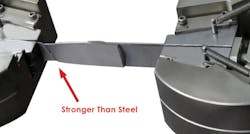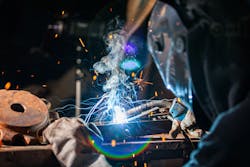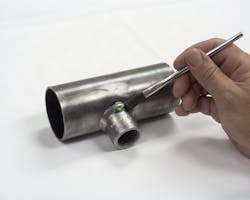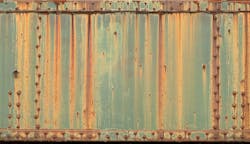What’s the Difference Between Structural Adhesives and Traditional Fasteners?
Nearly every industry uses adhesives in some way, shape, or form. However, transportation industries—including aerospace, automotive, and marine manufacturers—are leading the pack in adopting the latest adhesive technologies. These industries have learned that adhesives can cut cost, time, and weight while maintaining or improving performance and aesthetics, and being better for the environment. Adhesives also unlock new design possibilities out of reach when with “traditional” fasteners.
Savvy manufacturers recognize when to choose adhesives over welding or mechanical fasteners by looking for indicators in the manufacturing process and product environment. Examples of some key indicators are when manufacturing plans call for bonding different metals, for metals to be exposed to thermal cycling, or if galvanic corrosion (an electrochemical reaction between some metals) is a possibility. Adhesives are also indicated if products will be exposed to water and/or chemicals that may damage or penetrate other fasteners.
General advantages of adhesives include their ability to mitigate differential expansion rates, providing an inert barrier between potentially corrosive metals, and setting up a naturally watertight barrier. Adhesive formulas can also be designed or altered to resist specific chemicals.
Another common reason to choose adhesives is to lower the weight of a final product. The early-adopting industries mentioned above are all transportation industries where reducing weight is of critical importance. Even a slight reduction in an airliner’s weight yields significant reductions in operational costs over the life of the plane. However, you don’t have to cruise at 40,000 ft. to realize these benefits. Significant fuel savings can be realized by lowering the weight of cars and boats, and any weight reduction may make a product more portable, reduce shipping costs, or allow for installing additional components that give products new abilities and a competitive advantage.
Fusionbond adhesives from Hernon routinely beat common screws and rivets in impact analysis. When applied as a 1-by-1 in., single-layer lap joint, as in this test set--up, it withstands shear stress better than standard steel test coupons which stretch and break before the adhesive bond. When a material being bonded deforms or fails before the adhesive, it is referred to as “substrate failure.” This testing is consistent with the preferred use of adhesives, which perform best when applied to large, clean surfaces. When stresses are spread over a broad surface, adhesives offer stronger bonds than welding, rivets, and threaded assemblies.
Costs
The cost savings from using adhesives can be realized several ways. First, adhesives may offer lower material costs per application than mechanical fasteners, particularly when high-end or coated fasteners must be used. Second, savings come from reduced ordering, shipping, and stocking costs. A manufacturer may stock dozens of rivets, screws, bolts, and washers of different shapes and sizes, and those costs all be eliminated by a single adhesive. Third, the labor costs it takes to apply adhesives can be less than for other fastening methods. Consider just the time required to weld metals: The welder needs to set up and gather equipment, perform the weld, inspect and touch-up gaps, and then file down excess material or sharp points. Finally, the weld may need to be polished and have any discoloration addressed. Much of this labor can be eliminated by using an adhesive.
Aircraft manufacturers, along with auto makers and marine manufacturers, have been early adopters of adhesives as replacements for rivets and other mechanical fasters. They appreciate the simpler installation, lighter weight, and more uniform bond strengths.
Time
As mentioned above, labor needed for welding can be reduced by using adhesives. But what about threaded fasteners or rivets? Both methods nearly always involve several attachment points, and every attachment point requires more labor and often repeated work. Adhesives, by comparison, typically get applied across the substrate in a single step. Don’t forget, best practice for threaded assemblies used in structural bonds already require applying adhesives in the form of thread lockers. Applying thread lockers or thread sealants is another step that is eliminated by switching to structural adhesives.
One- and two-part epoxies are the most commonly used structural adhesives. In the past, a two-part epoxy (which typically consists of an adhesive and an activator that initiates curing) required the additional step of mixing the two parts at the proper ratio in a container to prepare the epoxy for application. Today, these two-part adhesives use disposable static mixing wands to blend a precise ratio during application.
A static mixing wand is a plastic tube full of slanted or curved plastic blades which fastens to the tip of a two-container cartridge filled with both parts of the epoxy. When the technician is ready, a plunger forces the two parts out of the cartridge and through the wand. As the two materials travel through the tubing, the blades mix them together. The blades do not move (hence the term static), but the structure forces the two epoxy components to weave around and past them in a choreographed combination process. This process continues through the length of the wand and results in an activated (curing) compound which comes out of the wand’s tip and directly onto substrates that will be bonded. Once mixed, technicians have a limited working time to move the substrates into position before the adhesive cures and hardens. Two-part/no-mix epoxies are also available where the activator is sprayed onto a substrate prior to the application of the adhesive and no mixing takes place. Process improvements like these continue to enhance the ease and speed of applying adhesives.
What about cure time? A rule of thumb with adhesives is that the longer the curing time, the stronger the final bond. However, although adhesives require time to reach full strength, many adhesives reach fixture times or handling points in minutes. Even if more time is required, no human labor is needed during curing. In addition, some adhesives cure in several ways to address curing delays, process problems, or other issues.
During speaker assembly, for example, manufacturers bonding magnets to plates may encounter a process problem of having excess adhesive squeeze out from the bonded magnet and plate. As speakers are often rotated and moved during production, this exposed adhesive may migrate or even splatter if it remains uncured. If the adhesive is multi-curing and light sensitive, a quick “bath” in high-intensity UV light will cure exposed adhesive, allowing manufacturers to continue with the assembly process. The remainder of the adhesive can cure anaerobically and the cured edges will help establish handling strength.
Welding is a time-consuming way to bond parts together, and only works on materials (such as metals) that can withstand the high temperatures.
Weight
Welding and most mechanical fasteners share a key ingredient: metal. Metals are heavy compared to an adhesive’s lightweight polymers, and even small metal components add significant weight when several fasteners are needed. This is one reason why aerospace firms, with planes once held together with thousands of metal fasteners, have turned to adhesives in search of lower weight in the final product.
Adhesives are not significantly lighter than metal fasteners, but additional weight can be cut due to the nature of adhesives and how they interact with substrates. Adhesives distribute a bond’s stress over the entire surface of the bonding area while spot welding, rivets, and other mechanical fasteners focus stresses at bond points. This concentration of stress creates inconsistent performance requirements for the substrates, often requiring the entire component be thicker or need additional material to support stresses focused at each point. The additional material and joint faces add weight and cost to the overall product, which might be eliminated by using adhesives.
Adhesives and sealants can even improve welds. Here, a weld is sealed with Hernon’s Weld Sealant 433 to eliminate cracks and micro-porosities that might lead to damage in the future.
Performance
Consider what happens in using a mechanical fastener such as a threaded assembly to attach two parts. The first step is to put a hole in both parts so the fastener can pass through them. This creates routes contaminants can travel through to compromise the joint and the parts’ interiors, and the holes damage the final product’s structural integrity.
The strongest and most resilient component is not one with a dozen holes in it but a solid, undamaged piece. Adhesives cause no damage when bonding components, so opting for adhesives improves product quality and overall structural integrity simply by doing no harm.
Welding also poses risks to products. Welding by its nature requires enough heat to melt the filler material. This heat often discolors and even warps the host metals. The possibility of warping increases when bonding thin parts or diverse metals. When substrates are thin, there is less material to absorb and dissipate heat from the welding process. When two or more metals are used, each metal may have a different thermal expansion rate and heat tolerance level. Not only can the difference in thermal expansion affect how the weld sets, but the weld will undergo further thermal stress as it cools. Once shipped, thermal cycling will continue stressing the joint, adding to whatever structural loads are already being carried.
Adhesives perform better against thermal cycling because they mitigate the stress from substrates’ expansions and contractions. Adhesives create semi-flexible bonds that absorb some of the stresses generated from thermal changes and adhesives react less to temperature changes within specified ranges.
What if sound or extreme vibration are a factor? Adhesives have an edge here, too. Once again, adhesives’ more flexible nature absorbs some of the stress. In fact, when vibrations are a factor with threaded assemblies, best practices call for thread lockers which are adhesives designed to assist threaded fasteners. Thread lockers ensure nuts and bolts don’t back out or loosen during vibrations or impacts.
Adhesives also have a quieting effect due to their visco-elastic properties. Sound vibrations are dampened as they pass through adhesive bonds. This advantage is of key importance for appliances such as washing and drying machines. Consumers are demanding easier access to appliances of all kinds. One way this desire is expressed is by bringing laundry rooms upstairs. As laundry appliances move out of the basement and into living spaces, quieter operation becomes an important selling point, and adhesives can help.
Many adhesives also boost corrosion resistance by acting as a buffer to galvanic effects between certain metals, as well as oxidations and similar effects from water and other chemicals. Beyond direct resistance to many chemical processes, adhesives seal joints as they fasten pieces together. With other methods, even welding, it takes additional steps to ensure a reliable seal.
Which is stronger? Advanced structural adhesives offer stronger bonds than mechanical fasteners, particularly when the bond covers a relatively large surface area. Most “impact resistant” structural adhesives are limited to a range of 15 to 20 J of impact strength, but some next-gen adhesives are stronger. For example, Fusionbond (from Hernon) has more than 50 J of impact resistance, the highest available. Fusionbond’s shear strength is also impressive, being greater than 3,500 psi for steel-to-steel bonds. (The “strength” of an adhesive is specific to the substrates tested. In this case, Fusionbond’s strengths are for steel-to--steel bonds. Bonding capabilities may vary widely from one substrate material to another.)
Finally, adhesives offer better long-term strength and quality when corrosive agents are involved. Even water and exposure to common chemicals can cause mechanical fasteners to rust, seize up, fail, or disintegrate over time while the right adhesives remain unaffected.
Rivets and other metal fasteners can lead to unsightly rust stains over time, a problem that can be eliminated by using adhesives instead.
Aesthetics
Speaking of rust, mechanical fasteners are notorious for creating long rust streaks after exposure to water. Welding too can gather pockets of dirty water that may stain or freeze, expanding and damaging products. In addition, welding leaves unsightly slag that must be filed down and polished before painting. Even then, welds often form obvious lumps or noticeably change the surface texture under layers of paint. Rivets and bolts also disrupt surfaces and need to protrude on both sides of the bonded substrates.
Adhesives, however, are out of sight between substrates, sealing against moisture and allowing for smooth, beautiful exteriors. This last point is critical for appliances and surfaces on medical equipment, where uninterrupted exteriors reduce the number of holes and crevices in which bacteria can hide and grow.
Environmental
In the past, adhesives rightfully developed a reputation for noxious fumes, thanks to the solvents used to keep them fluid and extend their working times. However modern adhesives come in a range of formulas, with many not using any solvents at all. Additionally, more stringent standards, such as NASA low outgassing standards, NSF certifications, and application-specific requirements (such as multi-cure capabilities) have driven the adhesives industry to innovate and reduced environmental impact and product waste. For example, although solvents were common in adhesives a few decades ago, out of the 5,000 formulas Hernon Manufacturing offers, only a handful of legacy products still contain solvents.
Eliminating solvents not only reduces the amount of chemicals released into the atmosphere, it also improves efficiency and lowers costs. Adhesives mixed with solvents necessitate that customers buy and transport materials that will evaporate as the adhesive or sealant cures. Similar materials with no solvents, sometimes referred to as “100% solid state” adhesives, let customers use everything in the purchased container. And when the solvent-free adhesives or sealants are used, the reduction in fumes results in a healthier and safer workplace for technicians and eliminates solvent-related health problems down the line.
Some adhesive suppliers, such as Hernon Manufacturing, have full-service labs that will develop custom adhesives when a manufacturing application is not a match with their offerings.
New Possibilities
Adhesives offer a secret weapon to manufacturers and designers. They can be applied when parts or joints are accessible or when it is just more convenient, then cured later using heat, anaerobic, UV light, or several curing methods in combination. Self-sealing adhesives include tiny glass capsules containing chemical activators. When two substrates are mated using such a material, shearing action bursts the capsules, releasing the activator and initiating curing. When this type of material is applied to fire sprinklers, for example, the sprinkler’s threads can be coated weeks ahead of installation while still in the factory, and the adhesive will still be pliable and inactive until sprinklers are screwed into position. This means no messy application of thread sealant in the field, no hauling buckets of sealant to and from the job site and, ultimately, a more efficient process.
Using adhesives, bonds can also be formed in places and at times when mechanical fasteners and welds are impractical or impossible. Examples include heat-cure adhesives which let manufacturers assemble products partially or entirely, then bond several surfaces at once by heating the entire product in a curing oven. In the case of plastic- and heat-sensitive substrates, welding is simply not an option because it destroys the plastic, but mechanical fastener may be also contraindicated if the plastic is thin or brittle and won’t tolerate a focused point of stress. In such a case, adhesives are clearly the best option. Then the fluid properties of adhesives allow manufacturers to create bonds between surfaces that are not fully accessible, and adhesives can be injected into an opening to fill gaps and bond surfaces that are otherwise hidden.
These unique abilities free process engineers to be more creative and allow new levels of efficiency that are out of reach with traditional fastening methods alone. When adhesives are the planned fastening method from the initial design stages of a product, bonding surfaces for adhesives can be built in, rather than retrofitted as they commonly are today, and the advantages of adhesives can be fully realized.
The reasons to choose adhesives for structural bonding are comprehensive. Cost, time, weight, performance, environmental concerns, and aesthetics all play a role in the decision. For many manufacturing applications, adhesives have crossed a critical point in advancement and are now successfully competing with alternate bonding methods on strength and longevity while offering clear advantages on cost, quality, and appearance. The advantages of adhesives may be clear, but the question of how to select the right adhesive for your application can be intimidating. Most adhesive manufacturers offer expert advice and are pleased to discuss your product and manufacturing methods in depth to ensure you get the exact right adhesive. Some manufacturers, such as Hernon Manufacturing, will go the extra mile, creating custom formulas and even designing custom automated dispensing machines to ensure integration into your assembly process goes smoothly. Whatever level of customization your application will require, be sure to discuss your project with representatives from multiple companies to get a fair sampling of the adhesive technology available.
If you have any questions regarding adhesives, please feel free to call a Hernon Manufacturing application engineer.







